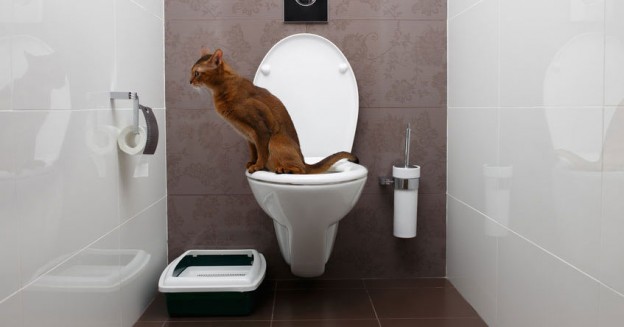Prevent Bathroom Emergencies: Don't Flush Cat Poop Down Your Toilet - Expert Guidance
Prevent Bathroom Emergencies: Don't Flush Cat Poop Down Your Toilet - Expert Guidance
Blog Article
What're your thoughts about Can You Flush Cat Poo or Litter Down the Toilet??

Introduction
As feline owners, it's important to be mindful of exactly how we deal with our feline close friends' waste. While it may seem practical to flush feline poop down the commode, this practice can have destructive consequences for both the setting and human health.
Ecological Impact
Flushing feline poop presents hazardous virus and parasites into the water system, positioning a substantial risk to water ecosystems. These pollutants can negatively influence aquatic life and concession water quality.
Wellness Risks
In addition to environmental worries, flushing pet cat waste can likewise pose wellness risks to people. Cat feces might include Toxoplasma gondii, a parasite that can cause toxoplasmosis-- a potentially extreme ailment, particularly for expecting ladies and people with damaged body immune systems.
Alternatives to Flushing
Fortunately, there are much safer and a lot more liable means to deal with feline poop. Think about the adhering to choices:
1. Scoop and Dispose in Trash
One of the most typical technique of throwing away pet cat poop is to scoop it right into a biodegradable bag and toss it in the garbage. Be sure to utilize a dedicated trash inside story and deal with the waste quickly.
2. Usage Biodegradable Litter
Go with naturally degradable pet cat clutter made from materials such as corn or wheat. These trashes are eco-friendly and can be safely gotten rid of in the garbage.
3. Bury in the Yard
If you have a lawn, consider burying pet cat waste in a designated area away from veggie yards and water resources. Be sure to dig deep sufficient to avoid contamination of groundwater.
4. Mount a Pet Waste Disposal System
Invest in a family pet waste disposal system specifically created for feline waste. These systems utilize enzymes to break down the waste, decreasing odor and ecological effect.
Final thought
Responsible pet dog possession extends beyond giving food and shelter-- it also involves proper waste management. By refraining from purging cat poop down the bathroom and choosing alternative disposal techniques, we can minimize our ecological impact and shield human wellness.
Why Can’t I Flush Cat Poop?
It Spreads a Parasite
Cats are frequently infected with a parasite called toxoplasma gondii. The parasite causes an infection called toxoplasmosis. It is usually harmless to cats. The parasite only uses cat poop as a host for its eggs. Otherwise, the cat’s immune system usually keeps the infection at low enough levels to maintain its own health. But it does not stop the develop of eggs. These eggs are tiny and surprisingly tough. They may survive for a year before they begin to grow. But that’s the problem.
Our wastewater system is not designed to deal with toxoplasmosis eggs. Instead, most eggs will flush from your toilet into sewers and wastewater management plants. After the sewage is treated for many other harmful things in it, it is typically released into local rivers, lakes, or oceans. Here, the toxoplasmosis eggs can find new hosts, including starfish, crabs, otters, and many other wildlife. For many, this is a significant risk to their health. Toxoplasmosis can also end up infecting water sources that are important for agriculture, which means our deer, pigs, and sheep can get infected too.
Is There Risk to Humans?
There can be a risk to human life from flushing cat poop down the toilet. If you do so, the parasites from your cat’s poop can end up in shellfish, game animals, or livestock. If this meat is then served raw or undercooked, the people who eat it can get sick.
In fact, according to the CDC, 40 million people in the United States are infected with toxoplasma gondii. They get it from exposure to infected seafood, or from some kind of cat poop contamination, like drinking from a stream that is contaminated or touching anything that has come into contact with cat poop. That includes just cleaning a cat litter box.
Most people who get infected with these parasites will not develop any symptoms. However, for pregnant women or for those with compromised immune systems, the parasite can cause severe health problems.
How to Handle Cat Poop
The best way to handle cat poop is actually to clean the box more often. The eggs that the parasite sheds will not become active until one to five days after the cat poops. That means that if you clean daily, you’re much less likely to come into direct contact with infectious eggs.
That said, always dispose of cat poop in the garbage and not down the toilet. Wash your hands before and after you clean the litter box, and bring the bag of poop right outside to your garbage bins.
https://trenchlesssolutionsusa.com/why-cant-i-flush-cat-poop/

As a person who reads on Can You Flush Cat Poop Down The Toilet?, I assumed sharing that article post was really useful. Are you aware of anybody else who is very much interested in the topic? Please feel free to share it. Many thanks for your time. Don't forget to come visit our blog back soon.
Book Service Report this page